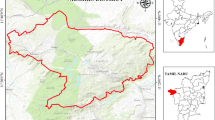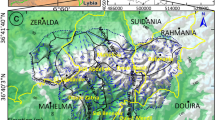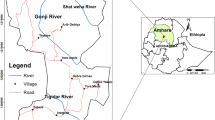Abstract
Landslides are a natural threat that poses a severe risk to human life and the environment. In the Kumaon mountains region in Uttarakhand (India), Nainital is among the most vulnerable areas prone to landslides inflicting harm to livelihood and civilization due to frequent landslides. Developing a landslide susceptibility map (LSM) in this Nainital area will help alleviate the probability of landslide occurrence. GIS and statistical-based approaches like the certainty factor (CF), information value (IV), frequency ratio (FR) and logistic regression (LR) are used for the assessment of LSM. The landslide inventories were prepared using topography, satellite imagery, lithology, slope, aspect, curvature, soil, land use and land cover, geomorphology, drainage density and lineament density to construct the geodatabase of the elements affecting landslides. Furthermore, the receiver operating characteristic (ROC) curve was used to check the accuracy of the predicting model. The results for the area under the curves (AUCs) were 87.8% for logistic regression, 87.6% for certainty factor, 87.4% for information value and 84.8% for frequency ratio, which indicates satisfactory accuracy in landslide susceptibility mapping. The present study perfectly combines GIS and statistical approaches for mapping landslide susceptibility zonation. Regional land use planners and natural disaster management will benefit from the proposed framework for landslide susceptibility maps.








Similar content being viewed by others
Data availability
Data associated with the manuscript will be made available upon reasonable request.
References
Abraham MT, Satyam N, Pradhan B, Alamri AM (2020) Forecasting of landslides using rainfall severity and soil wetness: a probabilistic approach for Darjeeling Himalayas. Water (switzerland) 12:1–19. https://doi.org/10.3390/w12030804
Ahmed B (2015) Landslide susceptibility mapping using multi-criteria evaluation techniques in Chittagong Metropolitan Area, Bangladesh. Landslides 12:1077–1095. https://doi.org/10.1007/s10346-014-0521-x
Aleotti P, Chowdhury R (1999) Landslide hazard assessment: summary review and new perspectives. Bull Eng Geol Env 58:21–44. https://doi.org/10.1007/s100640050066
Arabameri A, Pourghasemi HR, Yamani M (2017) Applying different scenarios for landslide spatial modeling using computational intelligence methods. Environ Earth Sci 76:1–20. https://doi.org/10.1007/s12665-017-7177-5
Arabameri A, Pradhan B, Rezaei K (2019a) Gully erosion zonation mapping using integrated geographically weighted regression with certainty factor and random forest models in GIS. J Environ Manag 232:928–942. https://doi.org/10.1016/j.jenvman.2018.11.110
Arabameri A, Pradhan B, Rezaei K et al (2019b) GIS-based landslide susceptibility mapping using numerical risk factor bivariate model and its ensemble with linear multivariate regression and boosted regression tree algorithms. J Mt Sci 16:595–618. https://doi.org/10.1007/s11629-018-5168-y
Arabameri A, Rezaei K, Cerda A et al (2019c) GIS-based groundwater potential mapping in Shahroud plain, Iran. A comparison among statistical (bivariate and multivariate), data mining and MCDM approaches. Sci Total Environ 658:160–177. https://doi.org/10.1016/j.scitotenv.2018.12.115
Arabameri A, Roy J, Saha S et al (2019d) Application of probabilistic and machine learning models for groundwater potentiality mapping in Damghan sedimentary plain, Iran. Remote Sens 11:3015
Arabameri A, Pradhan B, Rezaei K et al (2020) An ensemble model for landslide susceptibility mapping in a forested area. Geocarto Int 35:1680–1705. https://doi.org/10.1080/10106049.2019.1585484
Bolt BA, Horn WL, Macdonald GA, Scott RF (1986) Geological Hazards: Earthquakes - Tsunamis - Volcanoes - Avalanches - Landslides - Floods. Springer New York, New York. https://doi.org/10.1007/978-1-4615-7101-8
Brabb EE (1984) Innovative approaches to landslide hazard and risk mapping. In: International landslide symposium proceedings, Toronto, Canada. Japan Landslide Society, Tokyo, Japan, pp 17–22
Carabella C, Cinosi J, Piattelli V et al (2022) Earthquake-induced landslides susceptibility evaluation: a case study from the Abruzzo region (Central Italy). CATENA 208:105729
Chang K-T, Merghadi A, Yunus AP et al (2019) Evaluating scale effects of topographic variables in landslide susceptibility models using GIS-based machine learning techniques. Sci Rep 9:1–21
Chen Z, Wang J (2007) Landslide hazard mapping using logistic regression model in Mackenzie Valley, Canada. Nat Hazards 42:75–89
Chowdhuri I, Pal SC, Chakrabortty R et al (2021a) Torrential rainfall-induced landslide susceptibility assessment using machine learning and statistical methods of eastern Himalaya. Nat Hazards 107:697–722
Chowdhuri I, Pal SC, Chakrabortty R et al (2021b) Spatial prediction of landslide susceptibility using projected storm rainfall and land use in Himalayan region. Bull Eng Geol Env 80:5237–5258
Corominas J, van Westen C, Frattini P et al (2014) Recommendations for the quantitative analysis of landslide risk. Bull Eng Geol Env 73:209–263
Cruden DM (1991) A simple definition of a landslide. Bulletin of International Association of Engineering Geology 43:27–29. https://doi.org/10.1007/BF02590167
Devkota KC, Regmi AD, Pourghasemi HR et al (2013) Landslide susceptibility mapping using certainty factor, index of entropy and logistic regression models in GIS and their comparison at Mugling-Narayanghat road section in Nepal Himalaya. Nat Hazards 65:135–165. https://doi.org/10.1007/s11069-012-0347-6
Dou J, Yunus AP, Tien Bui D et al (2019) Evaluating GIS-based multiple statistical models and data mining for earthquake and rainfall-induced landslide susceptibility using the LiDAR DEM. Remote Sens 11:638
Dou J, Oguchi T, S. Hayakawa Y, et al (2014) GIS-Based landslide susceptibility mapping using a certainty factor model and its validation in the Chuetsu Area, Central Japan. In: Landslide Science for a Safer Geoenvironment. Springer International Publishing, Cham, pp 419–424
el Abidine RZ, Abdelmansour N (2019) Landslide susceptibility mapping using information value and frequency ratio for the Arzew sector (North-Western of Algeria). Bull Miner Res Explor 160:197–211
Fell R, Whitt G, Miner T, Flentje P (2008) Guidelines for landslide susceptibility, hazard and risk zoning for land use planning. Eng Geol 102:83–84
Ghosh S, van Westen CJ, Carranza EJM et al (2012) Generating event-based landslide maps in a data-scarce Himalayan environment for estimating temporal and magnitude probabilities. Eng Geol 128:49–62. https://doi.org/10.1016/j.enggeo.2011.03.016
Guzzetti F, Carrara A, Cardinali M, Reichenbach P (1999) Landslide hazard evaluation: a review of current techniques and their application in a multi-scale study, Central Italy. Geomorphology 31:181–216
Guzzetti F, Mondini AC, Cardinali M et al (2012) Landslide inventory maps: new tools for an old problem. Earth Sci Rev 112:42–66
Hasegawa S, Nonomura A, Nakai S, Dahal RK (2009) Drainage density as rainfall induced landslides susceptibility index in small catchment area. International Journal of Landslide Environment 1:27–28
Islam ARMT, Saha A, Ghose B et al (2022) Landslide susceptibility modeling in a complex mountainous region of Sikkim Himalaya using new hybrid data mining approach. Geocarto Int 37:9021–9046
Jia N, Xie M, Mitani Y et al (2010) A GIS-based spatial data processing system for slope monitoring. Int Geoinf Res Dev J 1:1
Kitutu MG, Muwanga A, Poesen J, Deckers JA (2009) Influence of soil properties on landslide occurrences in Bududa district, Eastern Uganda. Afr J Agric Res 4:611–620
Lee S, Pradhan B (2007) Landslide hazard mapping at Selangor, Malaysia using frequency ratio and logistic regression models. Landslides 4:33–41
Li B, Wang N, Chen J (2021) GIS-based landslide susceptibility mapping using information, frequency ratio, and artificial neural network methods in Qinghai Province, Northwestern China. Adv Civ Eng 2021:1–14. https://doi.org/10.1155/2021/4758062
Mallick J, Singh RK, AlAwadh MA et al (2018) GIS-based landslide susceptibility evaluation using fuzzy-AHP multi-criteria decision-making techniques in the Abha Watershed, Saudi Arabia. Environ Earth Sci 77:1–25. https://doi.org/10.1007/s12665-018-7451-1
Mandal K, Saha S, Mandal S (2021) Applying deep learning and benchmark machine learning algorithms for landslide susceptibility modelling in Rorachu river basin of Sikkim Himalaya, India. Geosci Front 12:101203
Merghadi A, Yunus AP, Dou J et al (2020) Machine learning methods for landslide susceptibility studies: a comparative overview of algorithm performance. Earth Sci Rev 207:103225. https://doi.org/10.1016/j.earscirev.2020.103225
Meten M, Bhandary NP, Yatabe R (2015) GIS-based frequency ratio and logistic regression modelling for landslide susceptibility mapping of Debre Sina area in central Ethiopia. J Mt Sci 12:1355–1372
Mohammady M, Pourghasemi HR, Pradhan B (2012) Landslide susceptibility mapping at Golestan Province, Iran: a comparison between frequency ratio, Dempster-Shafer, and weights-of-evidence models. J Asian Earth Sci 61:221–236
Nattino G, Pennell ML, Lemeshow S (2020) Assessing the goodness of fit of logistic regression models in large samples: a modification of the Hosmer-Lemeshow test. Biometrics 76:549–560
Onagh M, Kumra VK, Rai PK (2012) Landslide susceptibility mapping in a part of Uttarkashi district (India) by multiple linear regression method. Int J Geol Earth Environ Sci 2:102–120
Peng C-YJ, So T-SH (2002) Logistic regression analysis and reporting: a primer. Understanding Statistics: Statistical Issues in Psychology, Education, and the Social Sciences 1:31–70
Pham BT, Jaafari A, Prakash I, Bui DT (2019) A novel hybrid intelligent model of support vector machines and the MultiBoost ensemble for landslide susceptibility modeling. Bull Eng Geol Env 78:2865–2886. https://doi.org/10.1007/s10064-018-1281-y
Pourghasemi HR, Pradhan B, Gokceoglu C et al (2013) Application of weights-of-evidence and certainty factor models and their comparison in landslide susceptibility mapping at Haraz watershed, Iran. Arab J Geosci 6:2351–2365
Pradhan B, Mansor S, Pirasteh S, Buchroithner MF (2011) Landslide hazard and risk analyses at a landslide prone catchment area using statistical based geospatial model. Int J Remote Sens 32:4075–4087
Prakash N, Manconi A, Loew S (2021) A new strategy to map landslides with a generalized convolutional neural network. Sci Rep 11:1–15
Rai PK, Mohan K, Kumra VK (2014) Landslide hazard and its mapping using remote sensing and GIS. J Sci Res 58:1–13
Rasyid AR, Bhandary NP, Yatabe R (2016) Performance of frequency ratio and logistic regression model in creating GIS based landslides susceptibility map at Lompobattang Mountain, Indonesia. Geoenviron Dis 3:1–16
Rawat A, Kumar D, Chatterjee RS, Kumar H (2022) Reconstruction of liquefaction damage scenario in Northern Bihar during 1934 and 1988 earthquake using geospatial methods. Geomat Nat Haz Risk 13:2560–2578. https://doi.org/10.1080/19475705.2022.2122591
Roccati A, Paliaga G, Luino F et al (2021) GIS-based landslide susceptibility mapping for land use planning and risk assessment. Land 10:162
Roslee R, Mickey AC, Simon N et al (2017) Landslide susceptibility analysis (LSA) using weighted overlay method (WOM) along the Genting Sempah to Bentong Highway, Pahang. Malays J Geosci (MJG) 1:13–19
Roy J, Saha S (2019) Landslide susceptibility mapping using knowledge driven statistical models in Darjeeling District, West Bengal, India. Geoenviron Dis 6:1–18. https://doi.org/10.1186/s40677-019-0126-8
Saha A, Pal SC, Santosh M et al (2021a) Modelling multi-hazard threats to cultural heritage sites and environmental sustainability: the present and future scenarios. J Clean Prod 320:128713
Saha S, Sarkar R, Roy J et al (2021b) Measuring landslide vulnerability status of Chukha, Bhutan using deep learning algorithms. Sci Rep 11:1–23
Saha A, Villuri VGK, Bhardwaj A (2022a) Development and assessment of GIS-based landslide susceptibility mapping models using ANN, Fuzzy-AHP, and MCDA in Darjeeling Himalayas, West Bengal, India. Land 11:1711. https://doi.org/10.3390/land11101711
Saha S, Saha A, Hembram TK et al (2022b) Novel ensemble of deep learning neural network and support vector machine for landslide susceptibility mapping in Tehri region, Garhwal Himalaya. Geocarto Int 37:17018–17043. https://doi.org/10.1080/10106049.2022.2120638
Saha A, Villuri VGK, Bhardwaj A, Kumar S (2023b) A multi-criteria decision analysis (MCDA) approach for landslide susceptibility mapping of a part of Darjeeling District in North-East Himalaya, India. Appl Sci 13:5062. https://doi.org/10.3390/app13085062
Saha A, Villuri VGK, Bhardwaj A (2020) Assessment and preparation of landslide susceptibility zonation map by geospatial method using remote sensing and GIS. In: ACRS 2020 - 41st Asian Conference on Remote Sensing. pp. 461–470
Saha A, Villuri VGK, Bhardwaj A (2023a) Development and assessment of a novel hybrid machine learning-based landslide susceptibility mapping model in the Darjeeling Himalayas. Stoch Environ Res Risk Assess 8. https://doi.org/10.1007/s00477-023-02528-8
Sarkar S, Kanungo D, Patra A, Kumar P (2006) Disaster mitigation of debris flows, slope failures and landslides. GIS based landslide susceptibility mapping-a case study in Indian Himalaya. Universal Academy Press, Niigate, Japan
Selamat SN, Majid NA, Taha MR, Osman A (2022) Landslide susceptibility model using artificial neural network (ANN) Approach in Langat River Basin, Selangor. Malaysia Land 11:833. https://doi.org/10.3390/land11060833
Shano L, Raghuvanshi TK, Meten M (2020) Landslide susceptibility evaluation and hazard zonation techniques–a review. Geoenviron Dis 7:1–19
Tsangaratos P, Ilia I, Hong H et al (2017) Applying information theory and GIS-based quantitative methods to produce landslide susceptibility maps in Nancheng County, China. Landslides 14:1091–1111. https://doi.org/10.1007/s10346-016-0769-4
van Westen CJ, van Asch TWJ, Soeters R (2006) Landslide hazard and risk zonation - why is it still so difficult? Bull Eng Geol Env 65:167–184. https://doi.org/10.1007/s10064-005-0023-0
Van Westen CJ, Castellanos E, Kuriakose SL (2008) Spatial data for landslide susceptibility, hazard, and vulnerability assessment: an overview. Eng Geol 102:112–131
Wang H, Zhang L, Yin K et al (2020) Landslide identification using machine learning. Geosci Front. https://doi.org/10.1016/j.gsf.2020.02.012
Whiteley JS, Chambers JE, Uhlemann S et al (2019) Geophysical monitoring of moisture-induced landslides: a review. Rev Geophys 57:106–145
Wubalem A (2021) Landslide susceptibility mapping using statistical methods in Uatzau catchment area, northwestern Ethiopia. Geoenviron Dis 8:1. https://doi.org/10.1186/s40677-020-00170-y
Wubalem A, Meten M (2020) Landslide susceptibility mapping using information value and logistic regression models in Goncha Siso Eneses area, northwestern Ethiopia. SN Appl Sci 2:1–19
Yalcin A, Reis S, Aydinoglu AC, Yomralioglu T (2011) A GIS-based comparative study of frequency ratio, analytical hierarchy process, bivariate statistics and logistics regression methods for landslide susceptibility mapping in Trabzon, NE Turkey. CATENA 85:274–287
Zhang S, Bai L, Li Y et al (2022) Comparing convolutional neural network and machine learning models in landslide susceptibility mapping : a case study in Wenchuan County. 10:1–12. https://doi.org/10.3389/fenvs.2022.886841
Acknowledgements
The authors are thankful to the Department of Mining Engineering, Indian Institute of Technology (Indian School of Mines), Dhanbad, for giving the adequate environment for the research work.
Author information
Authors and Affiliations
Contributions
All authors contributed to the study conception and design. Material preparation, data collection and analysis were performed by Abhik Saha and Lakshya Tripathi under the supervision of Vasanta Govind Kumar Villuri and Ashutosh Bhardwaj. The first draft of the manuscript was written by Abhik Saha, and all authors commented on previous versions of the manuscript. All authors read and approved the final manuscript.
Corresponding author
Ethics declarations
Ethical approval
This article does not contain any studies with human participants or animals performed by any of the authors.
Consent to participate
Not applicable.
Consent to publication
Not applicable.
Competing interests
The authors declare no competing interests.
Additional information
Responsible Editor: Philippe Garrigues
Publisher's Note
Springer Nature remains neutral with regard to jurisdictional claims in published maps and institutional affiliations.
Rights and permissions
Springer Nature or its licensor (e.g. a society or other partner) holds exclusive rights to this article under a publishing agreement with the author(s) or other rightsholder(s); author self-archiving of the accepted manuscript version of this article is solely governed by the terms of such publishing agreement and applicable law.
About this article
Cite this article
Saha, A., Tripathi, L., Villuri, V.G.K. et al. Exploring machine learning and statistical approach techniques for landslide susceptibility mapping in Siwalik Himalayan Region using geospatial technology. Environ Sci Pollut Res 31, 10443–10459 (2024). https://doi.org/10.1007/s11356-023-31670-7
Received:
Accepted:
Published:
Issue Date:
DOI: https://doi.org/10.1007/s11356-023-31670-7




